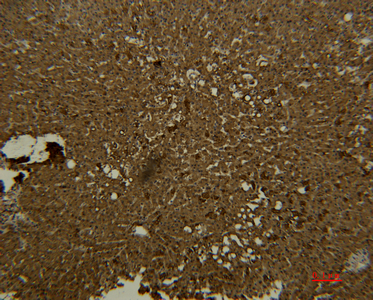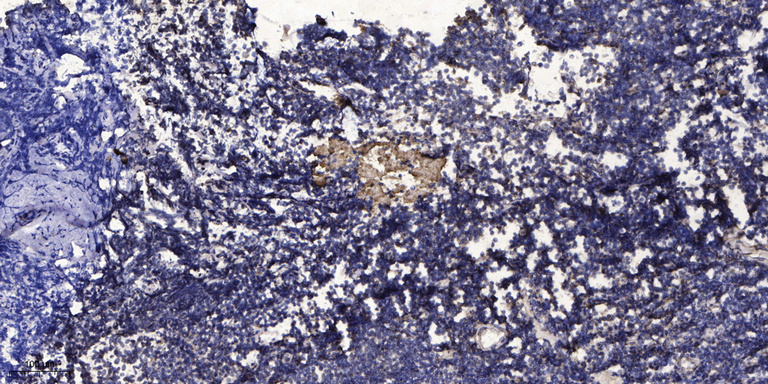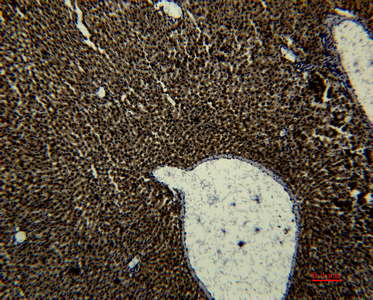Transferrin Monoclonal Antibody(7F4)
- Catalog No.:YM3152
- Applications:WB;IHC;IF;
- Reactivity:Human
- Target:
- Transferrin
- Fields:
- >>HIF-1 signaling pathway;>>Ferroptosis;>>Mineral absorption
- Gene Name:
- TF
- Protein Name:
- Serotransferrin
- Human Gene Id:
- 7018
- Human Swiss Prot No:
- P02787
- Mouse Gene Id:
- 22041
- Mouse Swiss Prot No:
- Q921I1
- Rat Gene Id:
- 24825
- Rat Swiss Prot No:
- P12346
- Immunogen:
- Synthetic Peptide of Transferrin
- Specificity:
- The antibody detects endogenous Human Transferrin protein.
- Formulation:
- PBS, pH 7.4, containing 0.5%BSA, 0.02% sodium azide as Preservative and 50% Glycerol.
- Source:
- Monoclonal, Mouse
- Dilution:
- WB 1:1000-2000 IF 1:200 IHC 1:50-300
- Purification:
- The antibody was affinity-purified from mouse ascites by affinity-chromatography using specific immunogen.
- Storage Stability:
- -15°C to -25°C/1 year(Do not lower than -25°C)
- Other Name:
- TF;Serotransferrin;Transferrin;Beta-1 metal-binding globulin;Siderophilin
- Observed Band(KD):
- 77kD
- Background:
- transferrin(TF) Homo sapiens This gene encodes a glycoprotein with an approximate molecular weight of 76.5 kDa. It is thought to have been created as a result of an ancient gene duplication event that led to generation of homologous C and N-terminal domains each of which binds one ion of ferric iron. The function of this protein is to transport iron from the intestine, reticuloendothelial system, and liver parenchymal cells to all proliferating cells in the body. This protein may also have a physiologic role as granulocyte/pollen-binding protein (GPBP) involved in the removal of certain organic matter and allergens from serum. [provided by RefSeq, Sep 2009],
- Function:
- disease:Defects in TF are the cause of atransferrinemia [MIM:209300]. Atransferrinemia is rare autosomal recessive disorder characterized by iron overload and hypochromic anemia.,function:Transferrins are iron binding transport proteins which can bind two Fe(3+) ions in association with the binding of an anion, usually bicarbonate. It is responsible for the transport of iron from sites of absorption and heme degradation to those of storage and utilization. Serum transferrin may also have a further role in stimulating cell proliferation.,online information:Transferrin entry,polymorphism:Different polymorphic variants of transferrin are known. The sequence shown is the predominant electrophoretic variant (C1 or TF*C1).,similarity:Belongs to the transferrin family.,similarity:Contains 2 transferrin-like domains.,subunit:Monomer.,tissue specificity:Expressed by the liver and secreted in plas
- Subcellular Location:
- Secreted.
- Expression:
- Expressed by the liver and secreted in plasma.
Effects of 8-Amino-Isocorydine, a Derivative of Isocorydine, on Gastric Carcinoma Cell Proliferation and Apoptosis." Current Therapeutic Research 94 (2021): 100624.
- June 19-2018
- WESTERN IMMUNOBLOTTING PROTOCOL
- June 19-2018
- IMMUNOHISTOCHEMISTRY-PARAFFIN PROTOCOL
- June 19-2018
- IMMUNOFLUORESCENCE PROTOCOL
- September 08-2020
- FLOW-CYTOMEYRT-PROTOCOL
- May 20-2022
- Cell-Based ELISA│解您多样本WB检测之困扰
- July 13-2018
- CELL-BASED-ELISA-PROTOCOL-FOR-ACETYL-PROTEIN
- July 13-2018
- CELL-BASED-ELISA-PROTOCOL-FOR-PHOSPHO-PROTEIN
- July 13-2018
- Antibody-FAQs
- Products Images
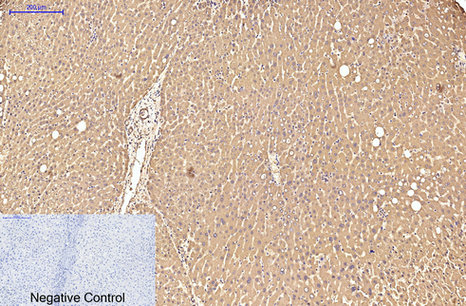
- Immunohistochemical analysis of paraffin-embedded Human-liver tissue. 1,Transferrin Monoclonal Antibody(7F4) was diluted at 1:200(4°C,overnight). 2, Sodium citrate pH 6.0 was used for antibody retrieval(>98°C,20min). 3,Secondary antibody was diluted at 1:200(room tempeRature, 30min). Negative control was used by secondary antibody only.

- Immunofluorescence analysis of Human-lung-cancer tissue. 1,Transferrin Monoclonal Antibody(7F4)(red) was diluted at 1:200(4°C,overnight). 2, Cy3 labled Secondary antibody was diluted at 1:300(room temperature, 50min).3, Picture B: DAPI(blue) 10min. Picture A:Target. Picture B: DAPI. Picture C: merge of A+B
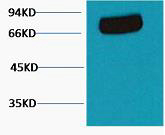
- Western blot analysis of Human serum, mAb diluted at 1:2000.
